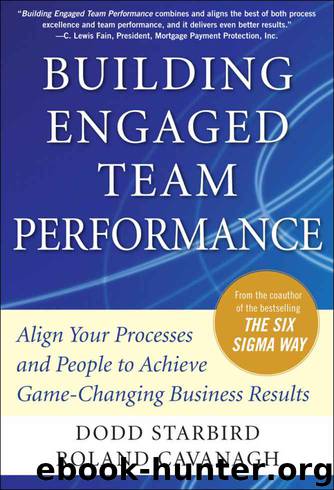Building Engaged Team Performance: Align Your Processes and People to Achieve Game-Changing Business Results by Dodd Starbird & Roland Cavanagh

Author:Dodd Starbird & Roland Cavanagh
Language: eng
Format: mobi
Publisher: McGraw-Hill Education
Published: 2010-10-14T14:00:00+00:00
After the GPS team piloted and implemented the process, the department received a challenge from some of the leaders who toured the new GPS work areas. The leaders noticed the paper quotes in the work trays and commented that we’d taken a step backward in the company’s twenty-first-century drive to become paperless. Dismayed, the team members explained that the paper actually helped them see the work. A paperless process could be achievable, but they believed that the team needed to learn first how to be efficient with paper. (As an aside, the GPS team very successfully went paperless in 2008.)
This is going to sound like heresy to some of you . . . as it did to those leaders back then: paperless is not automatically better.
We started another project with a client recently, and the client’s reason for launching the project was that its new paperless system (image and workflow, with a new automated system feed) had reduced its capacity and extended its cycle times. After some analysis, we found that the new high-tech tools added at least 25 percent more work time to the process compared with the time it took using the old manual way. Even worse, the up-front imaging process had two steps—“image” and “index”—with their associated handoffs, each proudly accomplished within 24 hours . . . resulting in 1.5 days of average cycle time before the production associate even first touched the work.
Also, the workflow system had great new capabilities to “suspend” and “wake up” work, allowing task requests to be touched, attempted, put down, and then brought up later to “follow up” (sometimes unsuccessfully). Any task that an associate couldn’t figure out how to do could be transferred to the in-box of another associate, and a task with missing information could be put away in the system with a “wake-up date” to attempt again later. We have a name for that type of technology: “bad habit enabling.”
When we asked why the client made the changes to go to the new system, we heard something like, “We had to make the changes in order to ensure data integrity as we migrated to other new systems. Our company is going paperless. We didn’t do the project to focus on being more efficient; it was something we had to do in order to link our systems.”
Sometimes a paperless system makes sense, and sometimes it doesn’t. In this case, it did make sense, but it had been implemented inefficiently. The project managers had simply assumed that paperless was better, and they hadn’t thought about finding ways to prevent handoffs and keep the work and status visual—the latter being a key characteristic of ETP. After a few process changes, some new measures, and a little bit of self-discipline in handling only the work that was ready to be done, the process was back up to speed.
Collaborative Norms
Download
This site does not store any files on its server. We only index and link to content provided by other sites. Please contact the content providers to delete copyright contents if any and email us, we'll remove relevant links or contents immediately.
Bad Blood by John Carreyrou(6514)
Rich Dad Poor Dad by Robert T. Kiyosaki(6349)
Principles: Life and Work by Ray Dalio(6165)
Playing to Win_ How Strategy Really Works by A.G. Lafley & Roger L. Martin(5841)
Management Strategies for the Cloud Revolution: How Cloud Computing Is Transforming Business and Why You Can't Afford to Be Left Behind by Charles Babcock(4507)
The Confidence Code by Katty Kay(4172)
Thinking in Bets by Annie Duke(4137)
American Kingpin by Nick Bilton(3734)
Delivering Happiness by Tony Hsieh(3351)
Project Animal Farm: An Accidental Journey into the Secret World of Farming and the Truth About Our Food by Sonia Faruqi(3160)
The Power of Habit by Charles Duhigg(3040)
Brotopia by Emily Chang(2982)
The Tyranny of Metrics by Jerry Z. Muller(2973)
Mastering Bitcoin: Programming the Open Blockchain by Andreas M. Antonopoulos(2964)
The Marketing Plan Handbook: Develop Big-Picture Marketing Plans for Pennies on the Dollar by Robert W. Bly(2938)
I Live in the Future & Here's How It Works by Nick Bilton(2917)
The Content Trap by Bharat Anand(2849)
Applied Empathy by Michael Ventura(2825)
Building a StoryBrand by Donald Miller(2824)
